|
|
Post by omegaman on Nov 14, 2013 20:37:27 GMT
This thread will be for all things clothing-related. Discussion on weather/climate specific items, traveling, layering, backpacking, questions, advice, etc... Personally, deciding what to wear and what to pack tends to be the hardest part of planning a trip or putting together a pack. I tend to overpack on clothing because a)I hate being wet b) I hate being cold c) I have some cool gear and I like to wear it  Most of what I will be contributing to this thread is based primarily on backpacking; thus, my focus is on weight:warmth ratios, packability, utility. Of course, in the discourse of prepping, I welcome all contributions to clothing (i.e. work wear, casual apparrel, CCW) that may be helpful to the community. Now, to kick it off...Baselayers! Baselayers come in many flavors and should be very carefully considered. To me, nothing can make or break a trip to the great outdoors more than baselayers. Temperature and physical activity are my prime factors. I generalize in 3 categories: lightweight (or silkweight, I interchange the terms), mid-weight, and expedition weight. Material is the next consideration. For me, the only 2 choices are a)synthetic b)wool. Cotton sucks. For me, baselayers must a)wick sweat and, subsequently, keep me warm and comfortable during physical activity 2)keep me warm with minimal bulk while static I wear lightweight tops & bottoms for moving in colder temps. I pack these in the summer/warm weather for my warming layers. My picks are: Synthetic  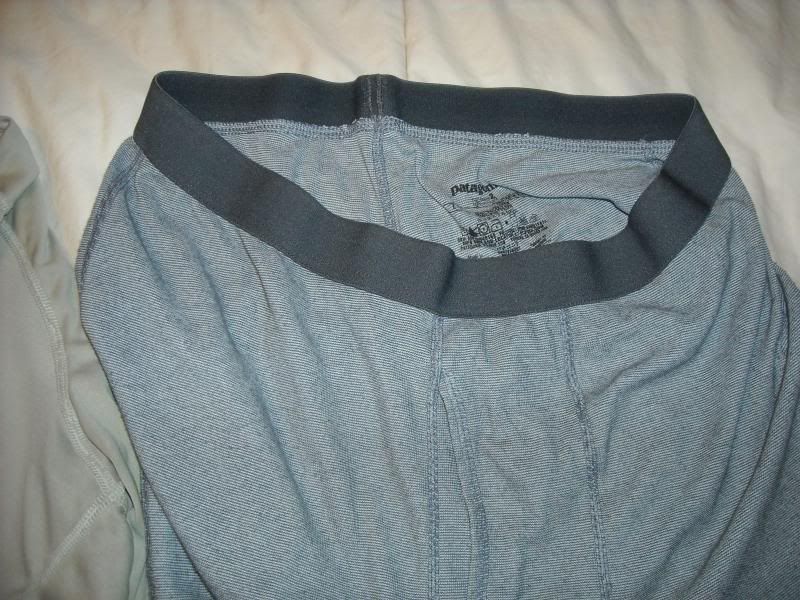 The biege set are Propper's silkweight layer, aka, PCU level I. Cheap, lightweight, fast drying. The blue-ish bottoms are Patagonia Capilene I, their lightweight offering. Very very comfortable and packable, just have to pay that Patagonia price. Worth it. Wool (specifically merino wool) 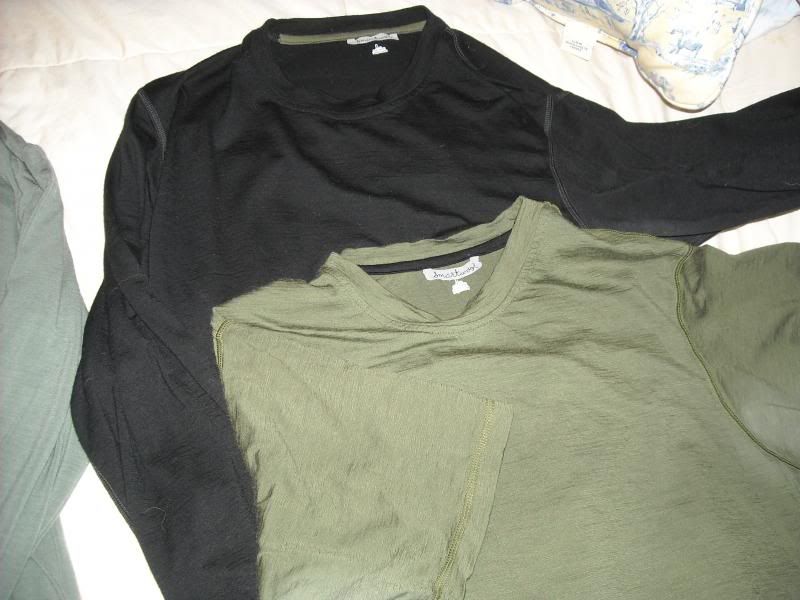 Smartwool lightweight short sleeve and long sleeve t-shirts. I love these. The short sleeve is typically what I wear in the summer while hiking. In colder temps, I'll change into it for a dry, next-to-skin layer, and then layer on top of that. The long sleeve often replaces the above synthetic top. The pros: merino wool base layers offer superior wicking and weight:warmth. They dry very fast and you can wear the same item for a few days on a trail without smelling like complete ass (just partial ass). I also wear Smartwool boxers in the summer (sorry, no pics of my underwear). Synthetics can get very ripe after a few days. Cons: like anything else nice, pricey. Also, the lightweight merino stuff wears out quickly. Moving on to mid-weight baselayers. I have 2 examples pictured here: 1) Patagonia "grid-fleece" style, identical to the PCU level II 2)Midweight merino wool from TAD and Smartwool.  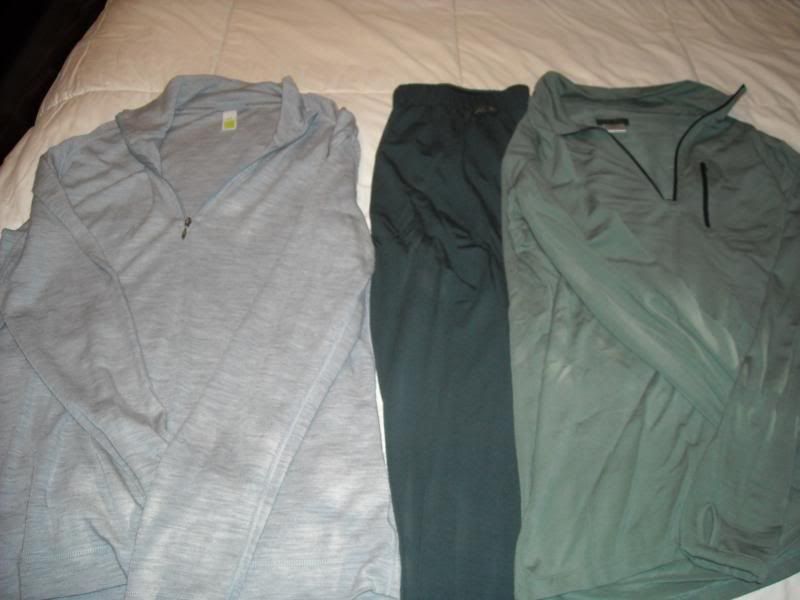 The grid-fleece, level II layers are mostly regulated for when I get to camp as my clean/dry relaxin' and sleepwear. It would have to dip into the teens for me to consider hiking in these. I have been seeing alot of level II surplus out there now for cheap, buy it. Beats the crap outta polypro. The wool offerings tend to be what I'll wear when backpacking in very cold temps. Mostly because of the superior moisture management properties over synthetics. I still sweat heavily when humping through the Blue Ridge in the winter. I don't get that cold, clammy feeling with a wet merino top. My TAD merino layers are fairly form-fitting, and work great under other layers (i.e. shells); whereas the Smartwool top is nice and loose and often ends up being my bum-around-camp layer, super comfortable. Final notes: Since I have spent the last decade in SoCal, Iraq, and South Carolina, I do not have expedition weight gear to highlight nor any experience with such. Socks: I consider socks as a baselayer. For me, wool is the only choice. I wear heavy ragwool socks the most. Even in the summer if I'm humping a long distance in the mountains. They just minimize hotspots, cushion well, and hold up better for me. I'll add merino liners in the winter. I always keep a dry/clean pair of socks to sleep in. My winter sleeping favorites are REI expedition weight merino. |
|
|
|
Post by omegaman on Nov 14, 2013 21:32:26 GMT
Warming layers: I consider the warming layer category to be what you add to your baselayers for warmth, but not really "outerwear" (i.e. minimal to no foul weather or environmental protection). I break this layer down to 1)Fleece and 2)Loft (either synthetic or down) Fleece is a popular choice for a warming layer. Many offerings can be found cheap, especially military surplus. Additionally, fleece jackets are also fashionable and can serve double-duty on or off the trail. Like baselayers, fleece comes in varying weights and styles. My issues with fleece (and why you will rarely see any in my pack) are that it is heavy and bulky. But, it is durable, relatively cheap, and requires minimal care. Now, lofty warming layers are my favorite. They pack down to nothing, minimal weight, and are way warmer than fleece. Flipside, they can be pricey, even synthetic offerings. Also, they require some more TLC than fleece, especially down! Columbia microfiber lightweight fleece. Often times, this is what I'll be wearing while hiking on cool days (layered with a smartwool t-shirt). Fairly packable, but not terribly warm for the weight and bulk. Omega_woman has an identical one, and it's her go-to for many outdoor adventures. 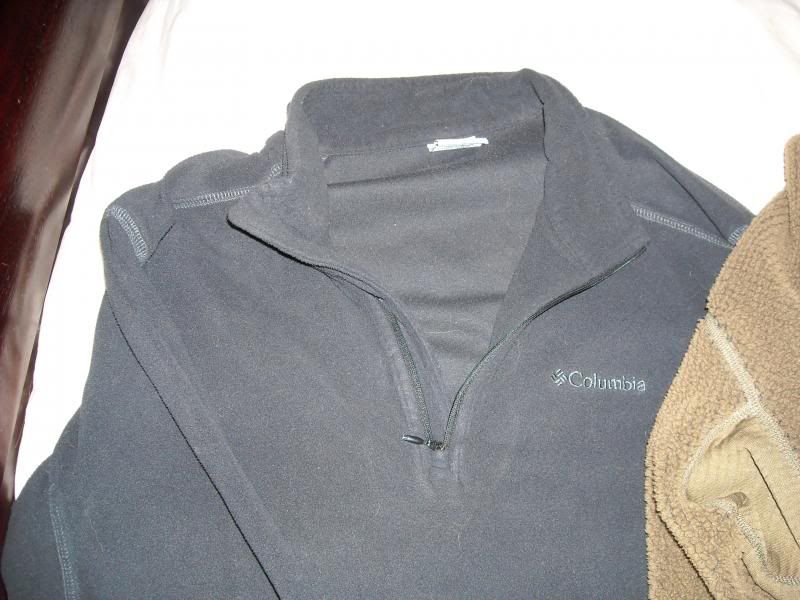 Patagonia level III fleece. This bad boy was Patagonia's version of the PCU system Level III layer. Very warm, but also very lightweight and packable. Nice lofty-style fleece, almost like grid-fleece on steroids. Downside, this is meant to create maximum warm air pockets under a shell. The slightest breeze cuts right through it. Oh, and it's pricey.  Mountain Hardwear fleece jacket. This is a traditional fleece jacket. The tight-weave face does a good job of blocking wind and the plush interior is super warm. It also has stretchy underarms that are not insulated for nice articulation and movement when active. Cons: heavy and does not pack well. It also has an "athletic fit" which is a little snug on the 'ol beer belly...  USMC "Black Fleece". This was an almost mythical piece of gear when I was in. You would hear rumors of this fleece jacket that actually kept you warm. I was finally issued one before my last deployment. Oddly enough, we were never allowed to wear it. Command actually thought it was suppossed to be worn underneath our utility top! Go figure. Anyway, this a very heavy-weight Polartec fleece jacket. Heavy and takes up most of a pack; but, they can be found cheap. This one usually stays in my car during the winter. 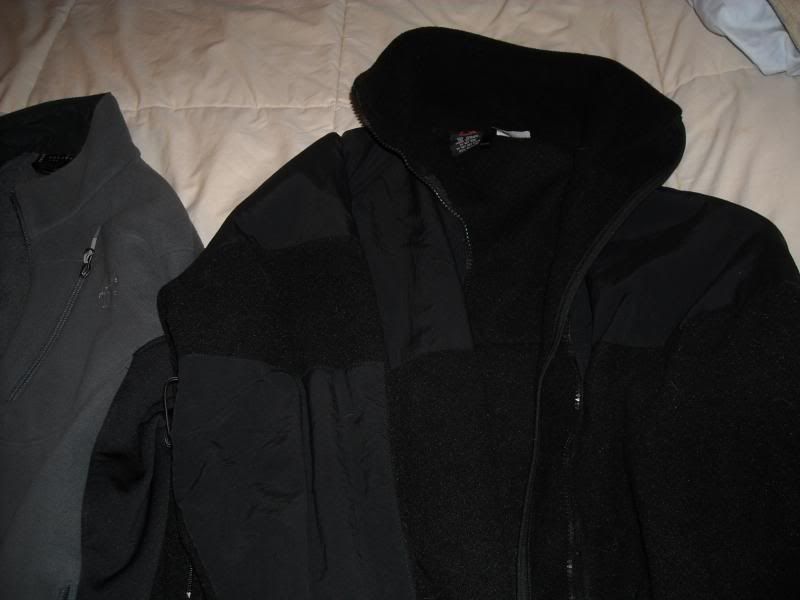 Now, let's get into some lofty gear! First up is some down selections: Patagonia down vest. This is one of my most used pieces of gear. Weighs nothing and packs down to a tiny little ball. Pull it out of my pack...presto! Downy warm goodness. I have this one sized a little smaller than my jackets because I want it to fit underneath my shells comfortably. Downside, it's Patagonia and down...not cheap. 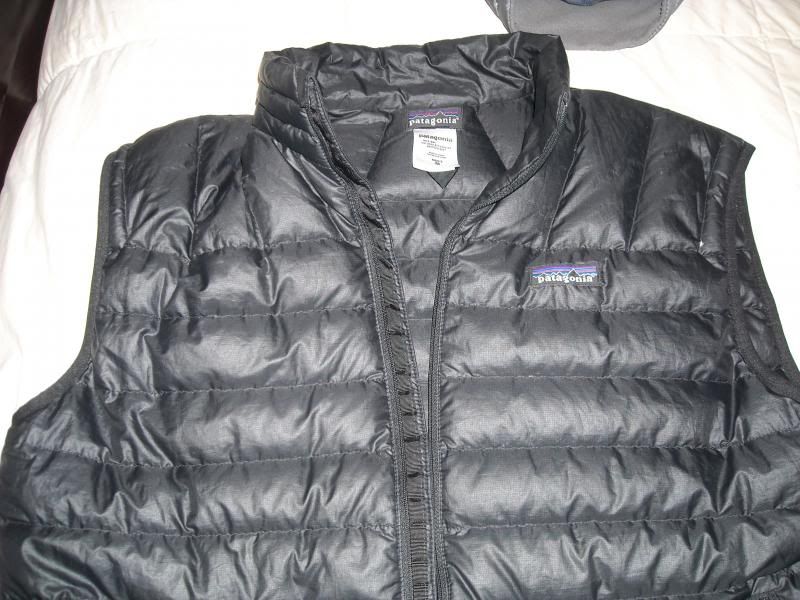 Cabela's down jacket. This looks bulkier and heavier than it actually is. If I think the temps will drop way low, I will pack this bad boy. Not only is it super warm, it doesn't feel all stuffy or restrictive. I know Cabela's stuff can be pricey, but keep an eye out for after season sales and clearance...I have picked up some pleasant surprises for a good price from them. 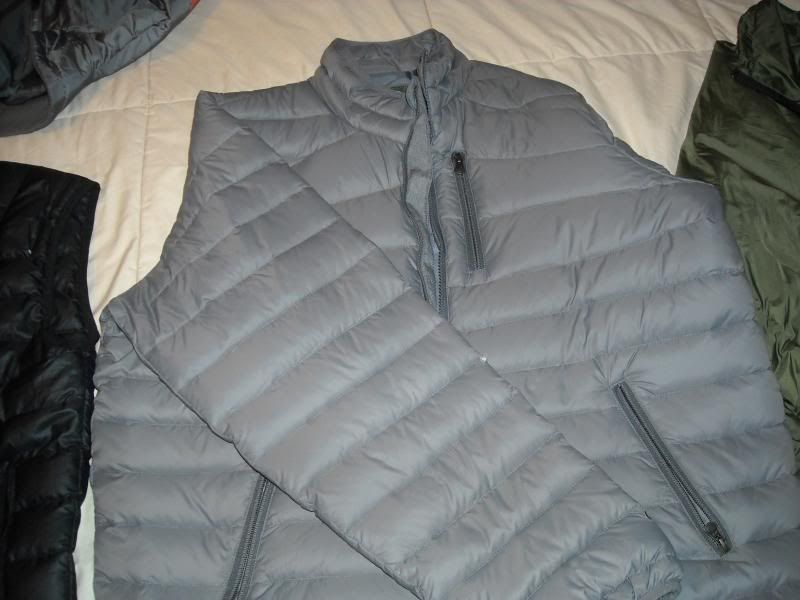 Synthetics: Snugpak Softie "Shirt". They call it a shirt, but that would be in a strictly artic context! But, it does have a luxurious microfiber lining meant to be worn next-to-skin, so it can function as an expedition weight baselayer. Anyway, this badboy is warm! Too warm. I think I've worn it once. Like all Snugpak gear, it is nice and built well (I believe this is actually UK issue). It is filled the super-rad Snugpak Softie insulation. All things considered, it does pack down well (still bulky) and it is fairly lightweight. If I live further north, it would get alot more use. 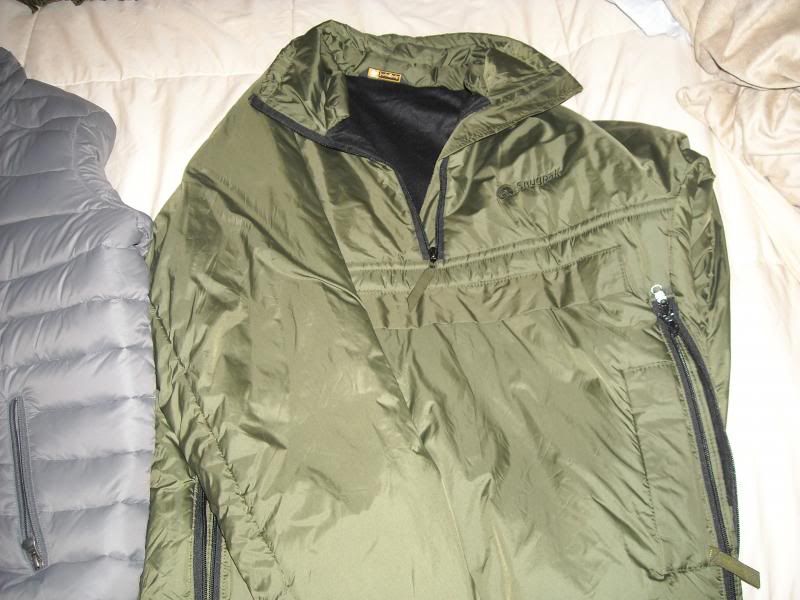 GoLite synthetic jacket. Next to my Patagonia down vest, this is my next go-to for backcountry layering! I often carry both for max warm and minimal bulk. As the name suggests, GoLite specializes in lightweight backpacking gear. This jacket is low on frills, but high on warmth and utility. This is another piece of gear that Omega_woman had to have as well. Bonus, GoLite products are very reasonably priced. Love this thing, you could easily fit this into a BDU cargo pocket. 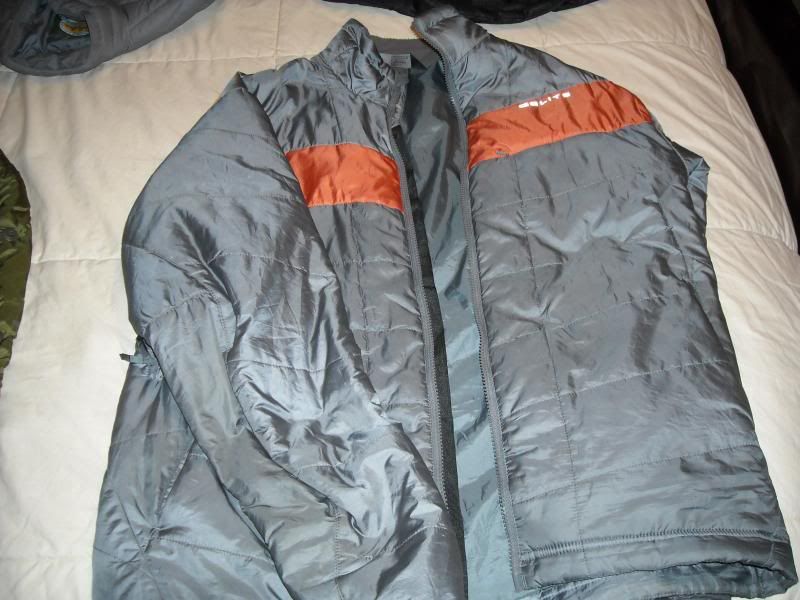 M-65 Field Pants Liners, aka, Woobie Pants! Love Love Love these! The insulating counterpart to the M-65 field coat liner, these pants feature the same insulation found in GI poncho liners. I always had a hard time justifying fleece pants in my pack, but then I remembered these. I had an old First Sergeant who swore by these and would sew up the crotch and add a drawstring to make them into PJs. They pack well and don't weigh much. There are few things I enjoy more than lounging by a fire on a cold winter night in these babies. They can be hard to find. Definitely not as prolific as their jacket counterparts; but, they are out there. I got ours (yes, the Mrs. had to have a pair, too) on ebay. They are cut short, so a Med-Reg goes down to about boot-top level. I found mine in Med-Long, which, with my 6'0" frame, reaches to my ankles.  |
|
|
|
Post by omegaman on Nov 15, 2013 20:53:05 GMT
Shells: I (and many others) put shells into 2 categories: 1)hardshell 2)softshell Both types come in many options, weight, and durability. Some companies offer products that blur the line between the two. I would consider many of Mountain Hardwear's softshells damn near hardshell waterproofness. 1) Hardshells: The most prolific example of hardshell outerwear would be the military's various offerings and generations of Gore Tex parkas and pants. Hardshells are meant to be waterproof and offer max protection in wet inclimate weather. Many companies offer their own propietary version of Gore Tex. They all work (or try to) on the same concept of using a semi-permeable membrane that keeps rain out, but lets metabolic moisture out...breathing, so to speak. Personally, I have yet to find that perfect hardshell that truely "breaths". If I'm active while wearing Gore Tex, I sweat like a pig. That's just me. Depending on what you want to pay, hardshell jackets and pants range from bulky, yet durable to lightweight, packable, yet delicate. Here is what I almost always have in my pack, the Marmot Precip rain jacket: 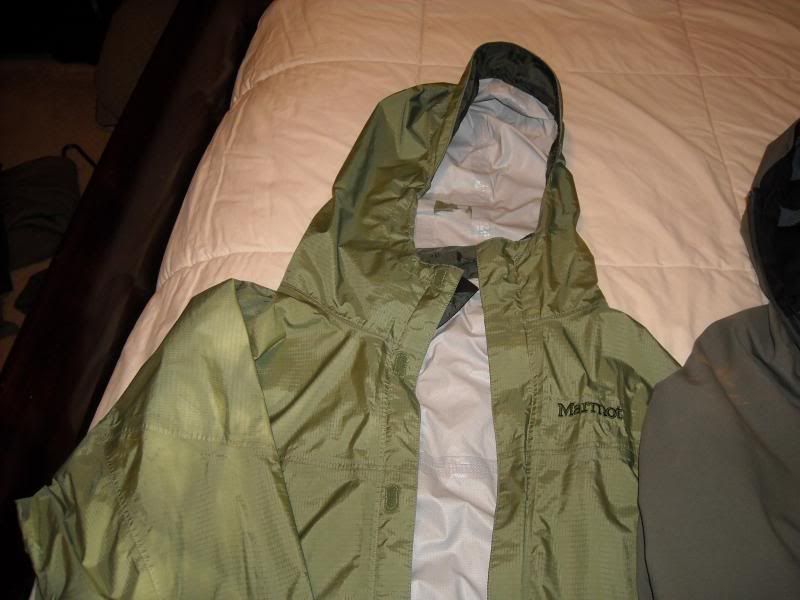 It keeps me "dry enough". It has a single layer membrane, and it really doesn't breath as well as other options. It is very lightweight and packable, not to mention reasonably priced. My next big clothing purchase, however, will likely be a higher-end hardshell from Arc'teryx and sport Gore Tex Prolite protection. I also usually pack the pants equivalent (REI brand in this case): 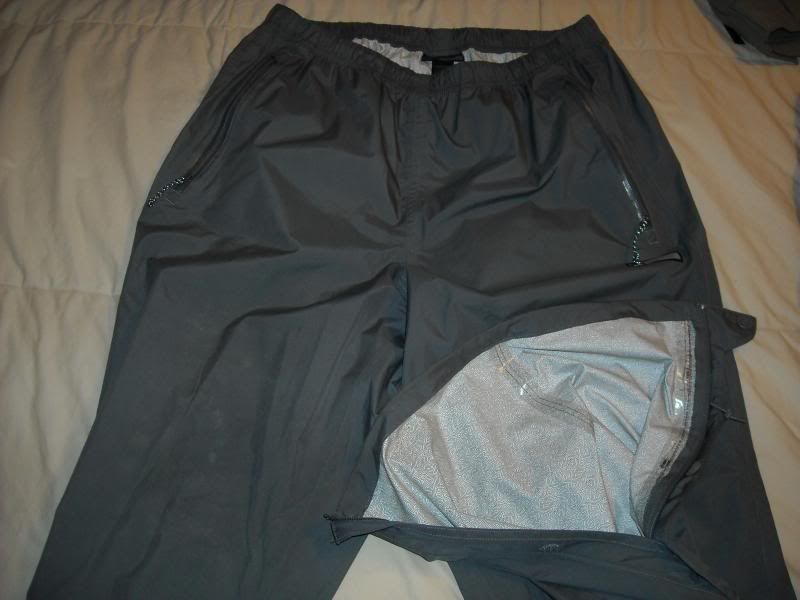 These rain pants pack so small and light, that it's hard not to bring them. They are designed to fit over whatever you are already wearing, much like sweat pants, and are actually very comfortable to hike in. I would not recommend bushwhacking in them. They also make for a decent pair of camp pants if you need/want something clean to wear. They do get clammy if worn next-to-skin. These matched with silkweight baselayer bottoms make a great combo! Now, if I know it is going to pour rain and the temps are cold, I will wear a dedicated pair of hardshell pants. Particularly, TAD hardshell pants: 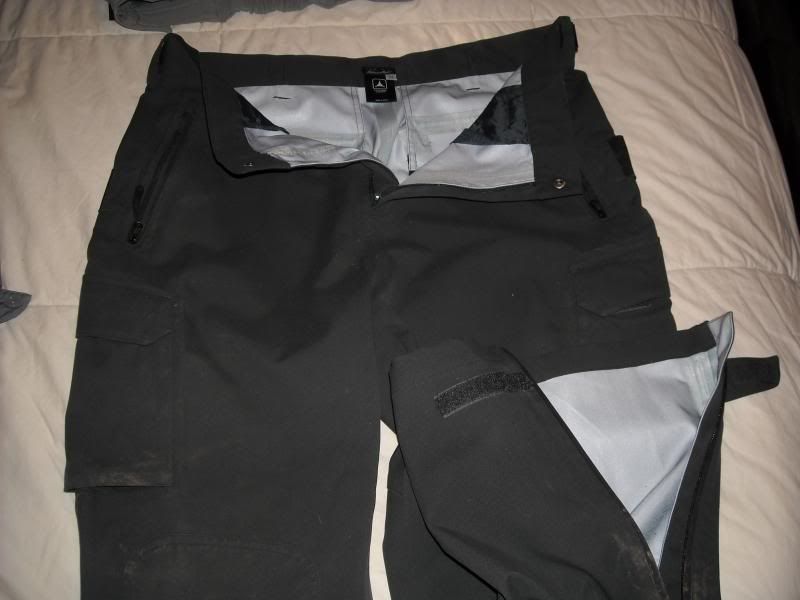 Unlike the lightweight rain pants, these are meant to be worn and function like a regular pair of pants. They do have calf and hip zippers for easy on/off. I prefer to wear baselayers under these, but they don't get as clammy as fast as single layer packable pants. As I said, these pants (and their GI issue Gore Tex cousins) are meant to be worn and used. They feature a durable outer shell and reinforced knees and ass. I literally slid down the side of a mountain in crappy, muddy, rainy, rocky terrain (remember that Doc!) and stayed dry while these babies had zero holes, rips, or tears. Now, these are something I don't pack. I wear them for the duration, and that requires cold and wet weather. 2)Softshells: Of the various types of shells and outerwear, I believe the softshell category has the most options and variations. Typically, a softshell is meant to provide protection from light rain, snow, and wind while retaining high breathability and comfort during physical activity. Here is a Patagonia softshell: 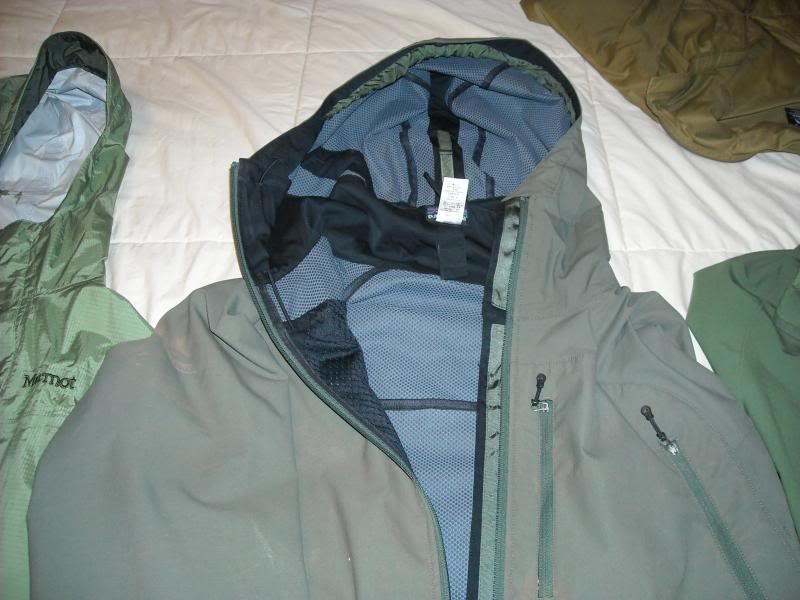 This offering is very heavy duty and durable, almost on the verge of an EWCS Gore Tex parka. Not very packable and, like the TAD hardshell pants, are usually worn during cold and wet adventures. It does breath very well and integrates with a pack and hip belt well. Another softshell example, and one of my favorites, is a simple Cabela's pullover: 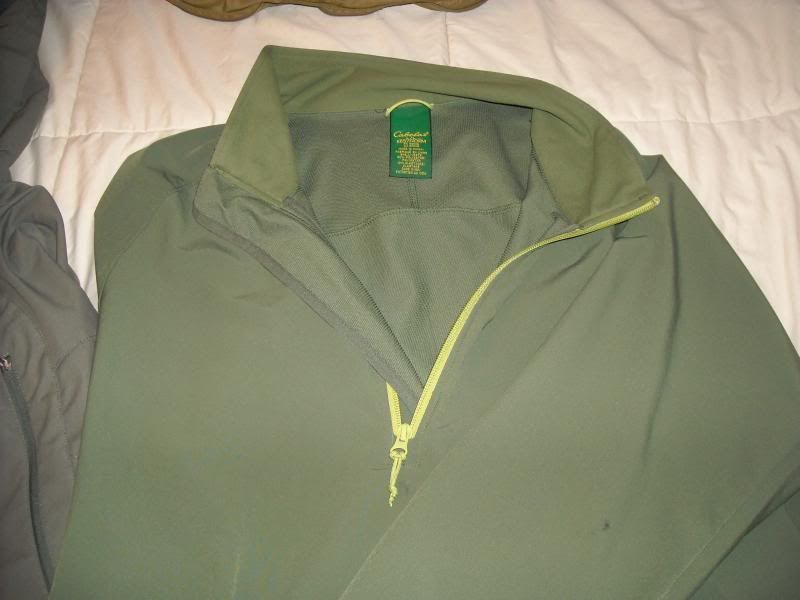 Pretty much a glorified windbreaker, it does have a little bit of lining for warmth, which I like because I can hike in it in mild weather and not overheat. Like any "true" softshell, it also shed light rain and snow very well. Bonus points for me, it packs well enough that it often rides with me in the fall and spring. I also like the 1/4 zip pullover design. I will also throw this into the softshell category, and that is the windshirt. Here is the Propper PCU system windshirt: 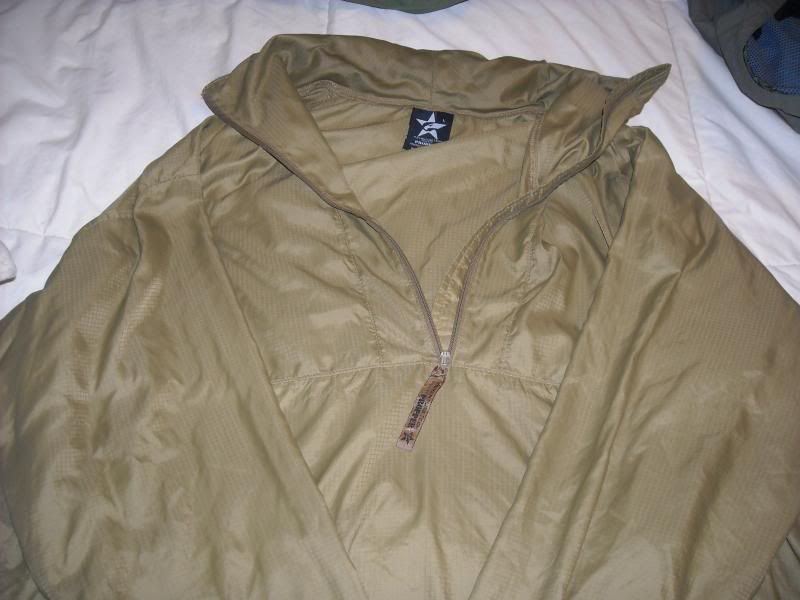 Honestly, I was always on the fence with windshirts. Essentially just a ripstop nylon pullover, I never saw the real use. I was wrong. At least this piece of gear was a very pleasant surprise. The ripstop material it is made of is very soft and comfortable, nowhere near as "swishy" I had expected. Water resistant enough and, as the name suggests, blocks wind very well. Where this piece of kit really shines is after backpacking for miles, taking a break, dropping ruck, and all of the sudden that sudden chill comes up your back through your sweat-soaked shirt...enter the windshirt. I keep mine in an exterior pocket for quick grabbing. Same for when I get to camp. Throw this on over my sweaty shirt and go about my camp chores. Additionally, it does trap heat well, so you do get some warmth utility out of it. What justifies carrying one? It only weights a couple of ounces and packs smaller than a tennis ball. Seriously, it would fit in most hipbelt pockets. This windshirt has become a permanent part of my backpacking, dayhiking, and work kit. Very versatile. I've been planning on doing a review on this one for about a year. And, of course, softshell pants! The heavy duty Patagonia counterpart to the above mentioned jacket: 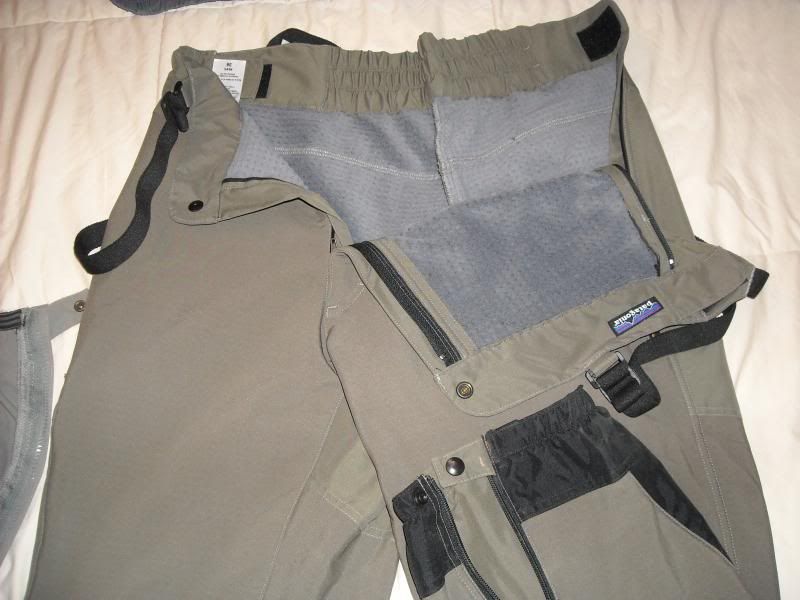 These follow in the footsteps of snowboarding-style pants. Although "softshell", you can spend alot of time in the snow in these before they wet through. They also have a nice fleece lining, making them too much for the climate I live in now. Now, my favorite...Blackhawk! Warrior Wear softshells: 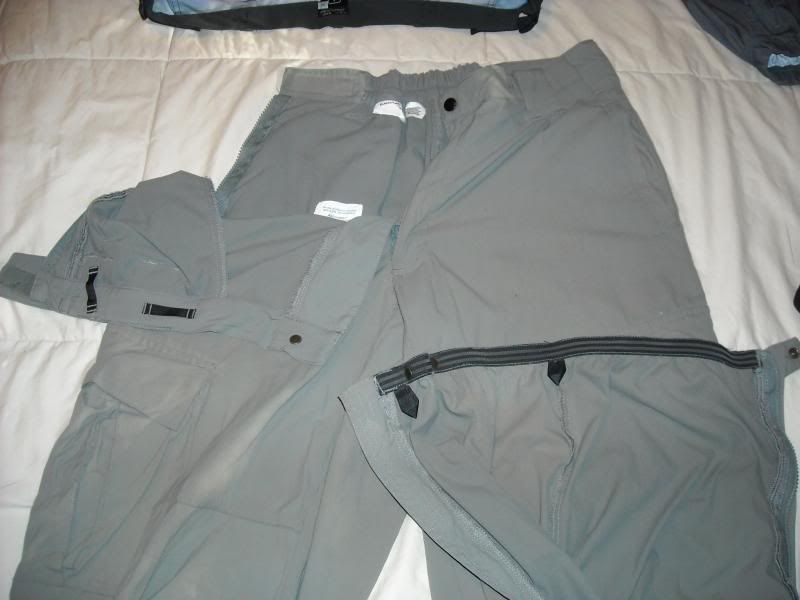 I don't know if they make these anymore, and I got them on a whim after seeing them on closeout on Blackhawk's website (these bastards orginally listed over $300, no wonder no-one bought them, even wound up getting the wife a pair!). These are my go-to cold weather pants. Soft, warm, and very very water resistent. Nice baggy cut (almost to the point of MC Hammer pants) and a pleasure to hike in. Start adding heavier baselayers, and you're good in these down to the 20's and teens. My only gripe with these, no back pockets. It's kinda weird. Just smooth ass back there. Anyway, I also have my USMC Gore Tex stuff, but it's packed up and I figure many folks who are reading this are already familiar with the surplus and GI issue Gore Tex gear. They definitely have their place, especially for the price. Personally, I believe the .mil Gore Tex pants are a very under-rated piece of gear. My .mil Gore Tex jacket stays in my work truck. Lastly, I want to talk about wool!!! I love wearing wool as an outer garment in the winter. In light rain or snow, I think it works just as well as many softshell offerings out there. There's also something very comforting to me about wearing a robust wool shirt or sweater while exploring the backcountry. My favorite wool clothes are: Pendleton wool plaid shirt 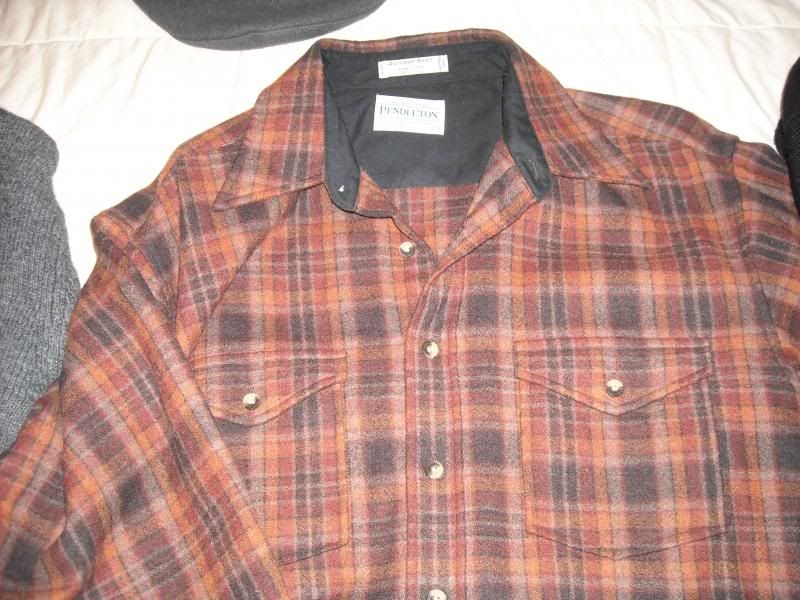 Classic ragwool sweater 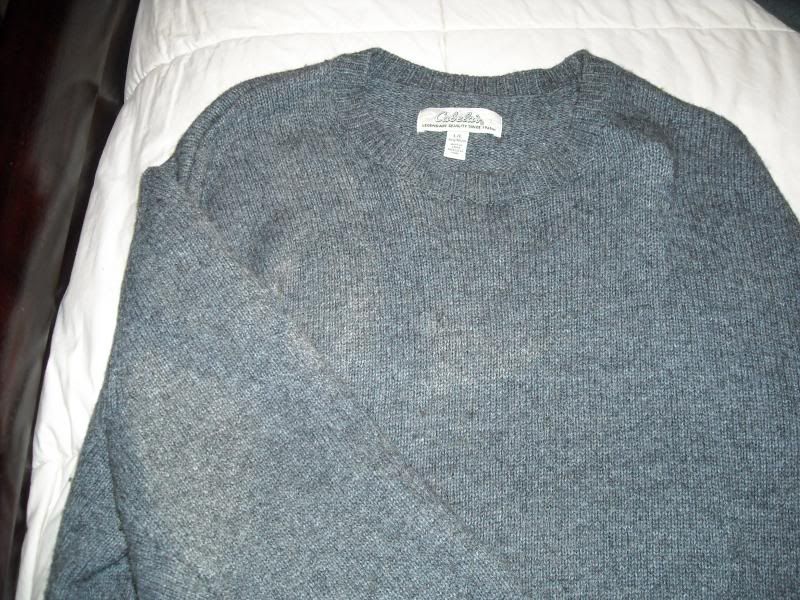 "Commando"-style ribknit wool sweater (in this case, the TAD special service sweater). Freakin' artic-worthy 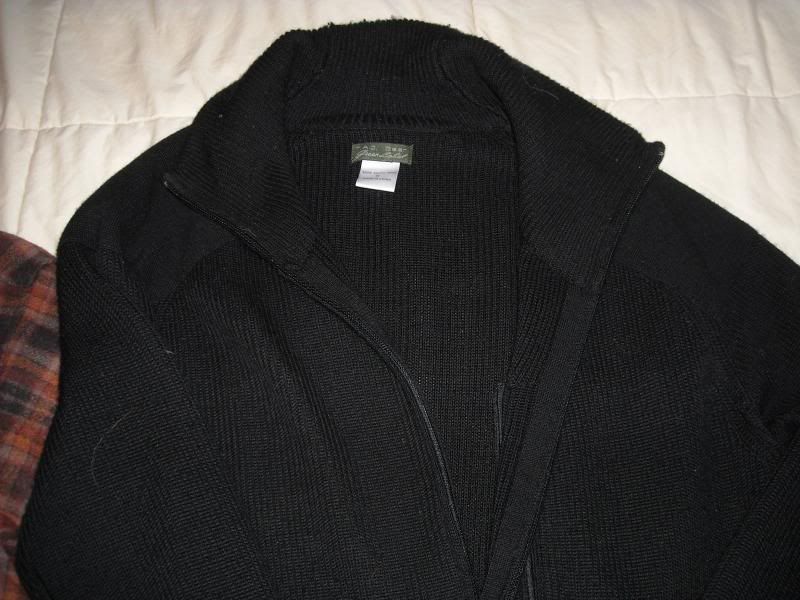 And, an interesting twist on the tactical softshell jacket, here is TAD's heavyweight merino wool stealth jacket. A super rad piece of gear that I often wear in town more than on the trail: 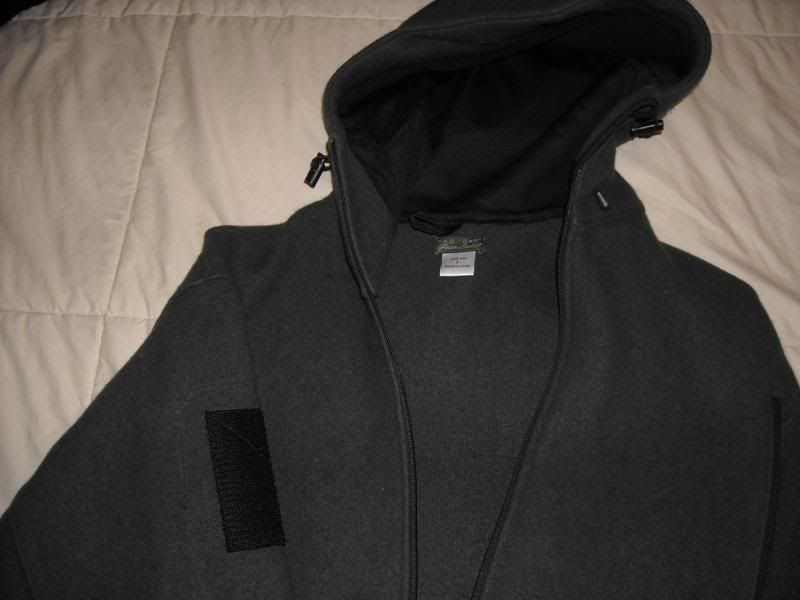 |
|
|
|
Post by Gingerbread Man on Nov 16, 2013 3:45:08 GMT
I want to snuggle with OM.
ETA: I got a Mountain Hardgear Compressor jacket this week and have been wearing it to work in the mid 20's. I've been warm with it while wearing a Addias Climatelite jacket and a fleece base layer. I plan on over nighting in my hammock in it. Stay tuned for a review.
|
|
|
|
Post by nxp on Nov 16, 2013 4:57:53 GMT
Wooooooo there's a lot of comfy, comfy gear in those posts, OM.
Can't believe you found a set of M65 liners in good shape - I haven't seen a good set of those in years. So. Comfy.
The nice thing, is, while there's a lot of Gucci gear, there's also a lot of really solid, inexpensive gear that's easy to find. The Cabelas stuff is almost always solid - I've had a lot of their gear picked up on sale or even used from the Bargin Cave (if you have a store local to you, we've got 3 in the state) and it's always been good value for the money. Not as highspeed as some, but also not as ridiculously priced either.
Wind shirts are like that lost $20 bill you find in a coat from last year when you were at the company seasonal party you were kicked out of. You completely forget about them, then at random see find it buried where it shouldn't be, and instantly you're reminded of a quality experience and the desire to have it again. Everyone needs one, they just don't realize it yet.
OM - now that you've gotten the gamut of crazy awesome and expensive to logger chic, can you whip up a list in both areas that covers the basics of all the thermal levels you'd like to have in your bag for your AO? Eg, for cheap go with this kit; base,insulation,shell,etc - for those that wanna piss the Jones's off, go these...
From the list/pics alone I'd say you've got the smaht's for it.
NXP
|
|
|
|
Post by omegaman on Nov 16, 2013 5:24:28 GMT
OM - now that you've gotten the gamut of crazy awesome and expensive to logger chic, can you whip up a list in both areas that covers the basics of all the thermal levels you'd like to have in your bag for your AO? Eg, for cheap go with this kit; base,insulation,shell,etc - for those that wanna piss the Jones's off, go these... Hmm...That sounds like fun. I have about a month left of unemployed bliss in the Blue Ridge escarpment before going coastal. I will say, I have found that a combo of Gucci gear and logger chic is always the best option for every environment I have been in. If you check out the "pics of yourself" thread, you'll see me wearing a TAD circa-08 softshell with Bass Pro Shops ragwool fingerless gloves  There's always a groovy balance between gear that's worth the $$$ and what just works. |
|
|
|
Post by Gingerbread Man on Nov 22, 2013 14:33:15 GMT
Alright, help me noodle this friends. I have a GHB and it contains a USGI poncho as a rain cover, jacket and a tarp. Pretty multi-use but it can only do one thing at a time. I recently swapped my EDC Maxped bag around* and I took the SOL tarp out because it takes up too much space in the bag. I'm thinking of adding it to the GHB. It's an extra pound but would allow me to have a dedicated tarp and I could set the poncho up as an extra insulating layer from the wind/cold. I'm not sure why this is bothering me, but it is. Help a bother out. Ditch the poncho? Keep and add the SOL tarp? Tarp only? It would total my GHB to about 21 lbs. I did a 2 mile trek with it and it's damn light as is. *To be posted soon, if my son will let me on my computer.  |
|
|
|
Post by nxp on Nov 22, 2013 16:39:54 GMT
GBM - Well, if it were me, I'd swap out the USGI ponch for a 8x10 Equinox siltarp (or equivalent - mo' tarp = mo' coverage = mo' betta) and a set of FroggToggs. They work, they're light, they're cheap, and you can layer with them - perfect for a bag that's going to sit and hang out waiting for failure.
Keep in mind, I'd be leary of using them for offroad bushwacking or rolling through the brambles, but for maintained trails and walking around they work great.
I tried the poncho thing, I really tried to like it, but overall it worked awesome if I was stationary and sucked on the move (for me), I'd rather have a dedicated coat/rainskirt over the poncho because of the mobility.
And yes, I said rainskirt. Paired with a set of gators, it's "A Good Thing" tm Martha.
|
|
|
|
Post by NamelessStain on Nov 22, 2013 17:05:21 GMT
Yesterday was an early Xmas for me. My Kifaru order came!! I got the 4 pack of pull-outs and 2 large 5 string compression sacks. I just stared at them last night figuring out what was going to get put in each.
|
|
|
|
Post by omegaman on Nov 22, 2013 19:39:28 GMT
GBM - Well, if it were me, I'd swap out the USGI ponch for a 8x10 Equinox siltarp (or equivalent - mo' tarp = mo' coverage = mo' betta) and a set of FroggToggs. They work, they're light, they're cheap, and you can layer with them - perfect for a bag that's going to sit and hang out waiting for failure. Keep in mind, I'd be leary of using them for offroad bushwacking or rolling through the brambles, but for maintained trails and walking around they work great. I tried the poncho thing, I really tried to like it, but overall it worked awesome if I was stationary and sucked on the move (for me), I'd rather have a dedicated coat/rainskirt over the poncho because of the mobility. And yes, I said rainskirt. Paired with a set of gators, it's "A Good Thing" tm Martha. Solid advice. I'm looking at adding a FroggToggs/DriDucks poncho to my main kit. The USGI poncho is great, but I understand the "can only use for one thing at a time" problem. However, in the role of a GHB, I dunno, GBM...I thought your kit was dialed in nice for your AO. Would a dedicated UL tarp and supplemental raingear give you more options? Yes; but, as NXP said, for a kit that spends most it's time just sitting there, I think you're good with the 'ol GI poncho. |
|
|
|
Post by Gingerbread Man on Sept 17, 2014 12:19:37 GMT
|
|
|
|
Post by omegaman on Sept 17, 2014 14:30:58 GMT
I have the JRB, and it is a fantastic multi-use quilt. It can pull TQ or UQ duty in a hammock. Omega_woman prefers to use one instead of a sleeping bag in conjunction with the Big Agnes sleeping pad--and I concur. Not familiar with the Mambe, my hesitation would lie with not having an array of reviews, thus not a clear picture on packability and weight. Looks nice, though, and it is constructed with top-notch materials. I question the waterproofness. Descriptions says rip-stop nylon--which is similiar to the USGI poncho liner, i.e. fairly water resistant, but not waterproof. I often find myself throwing a USGI poncho liner or Kifaru Woobie in my pack for casual overnighters in cooler temps. It is nice to sit around a fire all wrapped up (OK, and to give the dog something to sleep on  ). That said, the Kifaru Woobie is probably the most water resistant woobie/blanket/quilt I own and warmest synthetic option. I know I pimp that piece of gear alot, but it is well worth the price of admission. Anyway, excuse my digression, my vote is the JRB (given you have a means to keep it dry). Mr. D has one, too, that I am sure you could borrow. And, while I am thinking about, I also have a poncho liner made with Thinsulate insulation that I bought from Brigade QM that saw extensive use during my .mil days. Solid piece of gear and between the USGI and Kifaru in terms of warmth. |
|
|
|
Post by redeyes on Sept 17, 2014 21:47:40 GMT
|
|
|
|
Post by omegaman on Sept 18, 2014 1:49:30 GMT
|
|
|
|
Post by redeyes on Sept 18, 2014 3:43:51 GMT
I was thinking warmth gloves.
The different descriptions on different websites and the different acronyms make me confused.
That is good to know about the base layer. I bought a pair of Merino wool thermal underwear that I think are pretty nice but they were kinda expensive. $20 for a full set ain't so bad.
|
|





































 ). That said, the Kifaru Woobie is probably the most water resistant woobie/blanket/quilt I own and warmest synthetic option. I know I pimp that piece of gear alot, but it is well worth the price of admission.
). That said, the Kifaru Woobie is probably the most water resistant woobie/blanket/quilt I own and warmest synthetic option. I know I pimp that piece of gear alot, but it is well worth the price of admission.